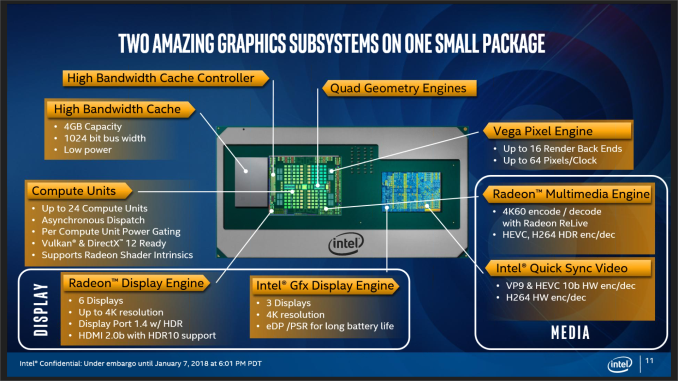Intel Core with Radeon RX Vega M Graphics Launched: HP, Dell, and Intel NUC
by Ian Cutress on January 7, 2018 9:02 PM ESTSo Why Two Sets of Graphics?
To answer this question, there can be a few possible answers.
The cynical approach is to say that Intel is rehashing a H-series design for the CPU portion, so rather than spending money to make masks that cuts it off, Intel is being cheap for what would be a low volume product.
A technical reason, which readers may or may not agree with, is to do with functionality and power. Despite these chips being 65W and 100W, we are going to see them being used in 15-inch and 17-inch high-end devices, where design is a lifestyle choice but also battery life is a factor to consider. For doing relatively simple tasks, such as video decoding or using eDP, firing up a big bulky graphics core with HBM2 is going to drain the batteries a lot faster. By remaining on the Intel HD graphics, users can still have access to those low power situations while the Radeon graphics and HBM2 are switched off. There is also the case for Intel’s QuickSync, which can be used in preference of AMD encoders in a power-restricted scenario.
The Radeon graphics in this case offers power-gating at the compute-unit level, allowing the system to adjust power as needed or is available. It provides an additional six displays up to 4K with the Intel HD graphics that has three, giving a total of nine outputs. The Radeon Graphics supports DisplayPort 1.4 with HDR and HDMI 2.0b with HDR10 support, along with FreeSync/FreeSync2. As a result, when the graphics output changes from Intel HD Graphics to Radeon graphics, users will have access to FreeSync, as well as enough displays to shake a stick at (if the device has all the outputs).
Users that want these new Intel with Radeon Graphics chips in desktop-class systems, might not find much use for the Intel HD graphics. But, for anything mobile or power related, and, especially for anything multimedia related, it makes sense to take advantage of the Intel iGPU.











66 Comments
View All Comments
Hixbot - Sunday, January 7, 2018 - link
Pigs just flew.tipoo - Sunday, January 7, 2018 - link
I'm pretty confident we'll see this in the 15" rMBP. If you remember Iris Pro which Apple nearly single handedly asked Intel for, I can see them being the ones to push for this as well.Wonder if that means a redesign, if not even just more batteries in the same space would be nice, or more room for cooling. And, cough, SD card. Most likely none of that, but the move up from the meager 80GB/s feeding the current GPUs would go a long way, even aside from the extra execution resources.
tipoo - Sunday, January 7, 2018 - link
That, uh, was meant to be a new comment.Comments, but editable.
nico_mach - Monday, January 8, 2018 - link
Based on the TDPs and looking around at the market, they seem tailor made for VR work on imacs, possible mac minis (though I think that line is dead as soon as the stock is sold off).willis936 - Monday, January 8, 2018 - link
Not even Tim Cook's Apple is crazy enough to put a 65W part in a 15" laptop. Hopefully at least.tyaty1 - Monday, January 8, 2018 - link
It is less than the combined TDP of CPU and the dGPU on the latest MBP.WinterCharm - Monday, January 8, 2018 - link
The MacBook Pro's current TDP is 87W.I'm amazed that they top out at 85ºC and barely throttle. It's kind of insane.
cditty - Sunday, January 21, 2018 - link
Actually, the 15" throttles a whole lot if you do anything 'Pro' with it. When I do video encodes, it begins slowing down after the first 10 solid minutes or so. I love the machine, the build, the look, BUT, you are wasting money if you get a CPU above the base, because you are rarely going to get full speed under sustained load. If they move to this model and can actually maintain speed, I will most certainly upgrade. The Kaby Lake MBP has been a disappointment to me.skavi - Monday, January 8, 2018 - link
You have to realize that we're already well past that point. There's a 45W CPU and 35W GPU in the current MacBook Pro.lefenzy - Monday, January 8, 2018 - link
The 15" rMBP ships with an 89W charger. So only the 65 W solutions would work here.